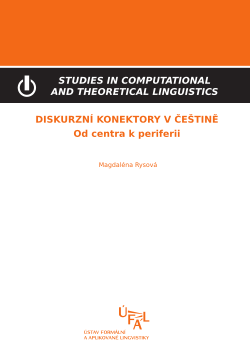Rysová Magdaléna: Diskurzní konektory v češtině: Od centra k periferii
| RYSOVÁ MAGDALÉNA (2018). Diskurzní konektory v češtině: Od centra k periferii. ISBN 978-80-88132-05-9. 198 pp. |
Abstrakt:V knize se zabýváme popisem a analýzou diskurzních (tj. textových) konektorů v češtině, tedy tím, jakými jazykovými prostředky je možné vyjadřovat v textu významové vztahy. Výzkum přitom neomezujeme na předem stanovenou skupinu výrazů (danou například příslušností k určitým slovním druhům, jako jsou souřadicí a podřadicí spojky), ale snažíme se nalézt a obecně popsat všechny jazykové prostředky v češtině, které mají schopnost spojovat jednotlivé úseky textu v jeden koherentní celek. Zaměřujeme se především na méně probádané víceslovné konektivní struktury typu to je důvod, proč; kvůli tomu; z těchto důvodů atd., pro které užíváme označení sekundární konektory (za primární konektory považujeme především konektivní synsémantika typu však, nebo, a, ale, proto apod.). Diskurzní konektory jsou velmi obecně chápány jako jazykové výrazy, které mají v textu schopnost signalizovat různé sémanticko-pragmatické vztahy. Existuje ovšem mnoho jazykových teorií, které se v konkrétním popisu diskurzních konektorů výrazně liší. Neexistuje tedy jediná, obecně přijímaná definice těchto výrazů. O jejich podstatě a charakteristice se v lingvistice vedou diskuze. Cílem této práce je na základě podrobného jazykového výzkumu přispět k obecnému vymezení a definici diskurzních konektorů (nejen pro češtinu). V naší práci nejprve popisujeme jazykové teorie zabývající se problematikou diskurzu (či textu). Zaměřujeme se přitom na jednotlivá pojetí diskurzních konektorů a na obecná kritéria, podle kterých můžeme tyto prostředky v jazyce definovat. Podrobná analýza diskurzních konektorů (s důrazem na konektory sekundární) pak vychází z anotovaných dat Pražského diskurzního korpusu (PDiT) obsahujícího psané publicistické texty. V práci představujeme principy a výsledky anotace sekundárních konektorů v PDiT. Zaměřujeme se především na srovnání primárních a sekundárních konektorů podle četnosti, podle významových vztahů, které v textu vyjadřují, nebo podle toho, zda se vyskytují častěji mezivětně či vnitrovětně. Dále přinášíme srovnání anotace sekundárních konektorů v češtině a obdobných jazykových prostředků v angličtině (provedené na datech pensylvánského korpusu Penn Discourse Treebank) a stručně srovnáváme výskyt a užívání sekundárních konektorů v psané a mluvené češtině (s využitím korpusů PDiT a DIALOG). Z výsledků analýzy diskurzních konektorů se snažíme vyvodit obecné teoretické závěry o zkoumaných jazykových prostředcích. Zaměřujeme se přitom na definici diskurzních konektorů, stanovení principů, na základě kterých je možné konektory rozpoznat v textu, či na vymezení hranic mezi konektory primárními a sekundárními (především na základě jejich lexikální, syntaktické a sémantické charakteristiky). V závěru práce představujeme faktory ovlivňující výběr diskurzních konektorů v textu, resp. snažíme se nalézt a popsat principy a tendence v užívání konektorů. Podrobný výzkum diskurzních konektorů a obecné závěry představené v této práci by mohly vést ke zlepšení porozumění významovým vztahům v textu, a tedy k většímu porozumění zákonitostem výstavby textu jako celku. |
Summary
The book focuses on description and analysis of discourse connectives in Czech, i.e. on the issue by which language means it is possible to express sense relations within a text. The book is not limited to any parts of speech (like conjunctions or structuring particles) but it tries to find and describe all language means in Czech with the ability to connect two pieces or units of a text into a coherent complex. The book investigates discourse connectives in Czech with respect to so-called secondary connectives (i.e. mainly multiword phrases like to je důvod, proč -- that is the reason why; kvůli tomu -- because of this; z těchto důvodů -- for these reasons etc., in opposition to primary connectives like však -- however, nebo -- or, a -- and, ale -- but, proto -- therefore etc.).
Discourse connectives are (in general terms) understood as language expressions that signal semantico-pragmatic relations within a text. However, there are many theories that significantly differ in the concrete description of these expressions. Therefore, there is not a generally accepted and universal definition of discourse connectives and their description and characteristics is still a matter of linguistic discussion. The aim of this book is to contribute to the general delimitation and definition of discourse connectives (not only in Czech) on the basis of a detailed language research.
Firstly, we describe various language theories focusing on description of discourse (or text). We concentrate especially on the individual approaches to discourse connectives and on the general criteria according to which we may define these expressions in language.
The detailed analysis of discourse connectives (with the emphasis on secondary connectives) is based on the annotated data of the Prague Discourse Treebank (PDiT) containing written newspaper texts. In the book, we introduce the principles and results of the annotation of secondary connectives in the PDiT. We focus mainly on the comparison of primary and secondary connectives according to their frequency in authentic texts, according to sense relations they express or according to whether they occur more often inter- or intra-sententially. We compare then the annotations of secondary connectives in Czech with the similar expressions in English (carried out on the data of the Pennsylvanian corpus Penn Discourse Treebank) and we shortly compare the occurrence and usage of secondary connectives in written and spoken Czech (in the PDiT and in the corpus DIALOG).
On the basis of the analysis of discourse connectives, we try to draw several theoretical conclusions about these expressions. We focus mainly on the definition of discourse connectives, on general principles describing how it is possible to detect these expressions in authentic texts, and on the delimitation of the boundaries between primary and secondary connectives (mainly with respect to their lexical, syntactic and semantic characteristics). Finally, we present factors influencing selection of discourse connectives in authentic texts -- we try to find and describe the principles and tendencies in using connectives.
The detailed analysis of discourse connectives and the general conclusions presented in this book might improve the understanding of semantico-pragmatic relations in texts and in this sense also the understanding of a text structure as a whole.





